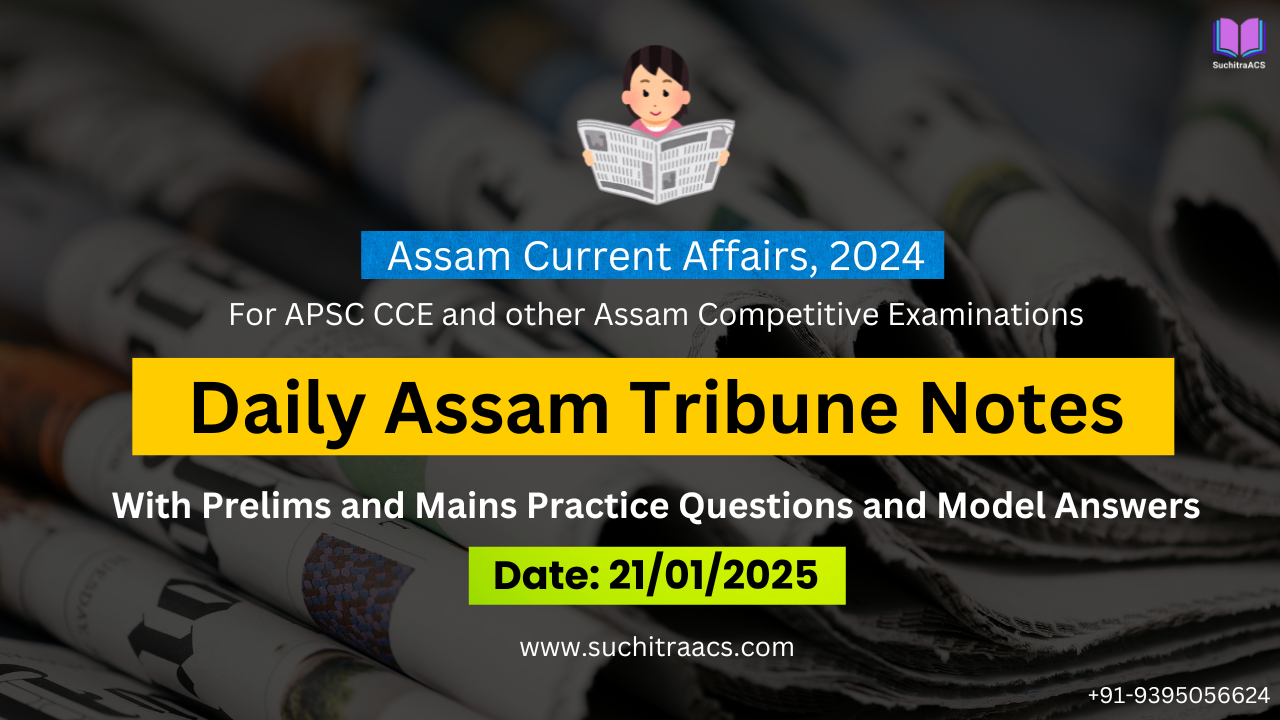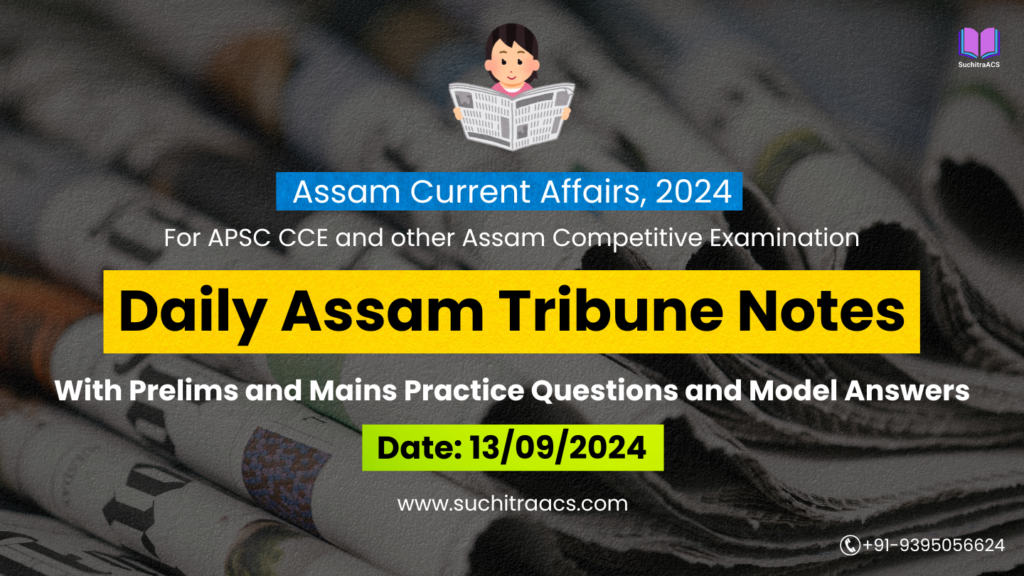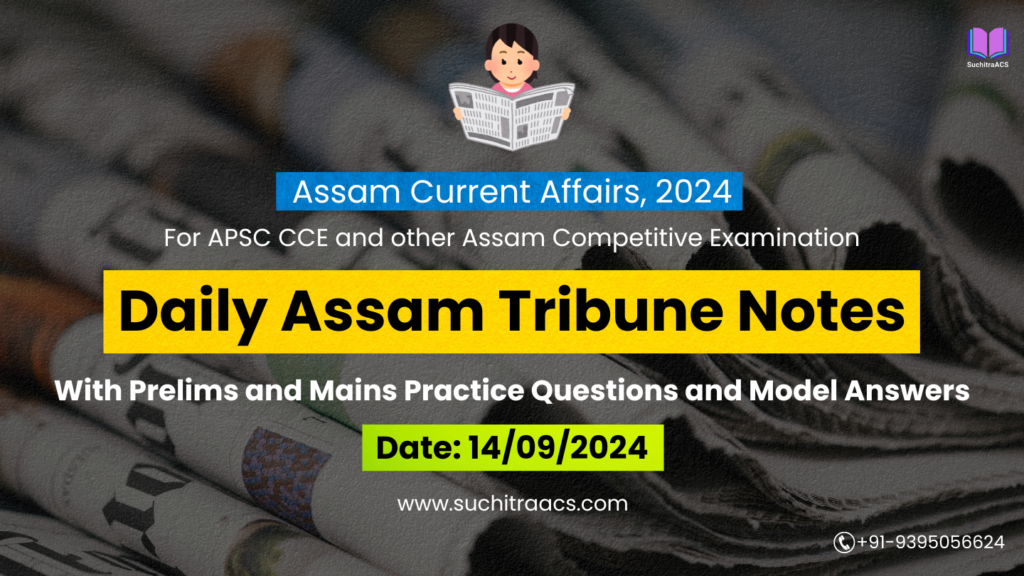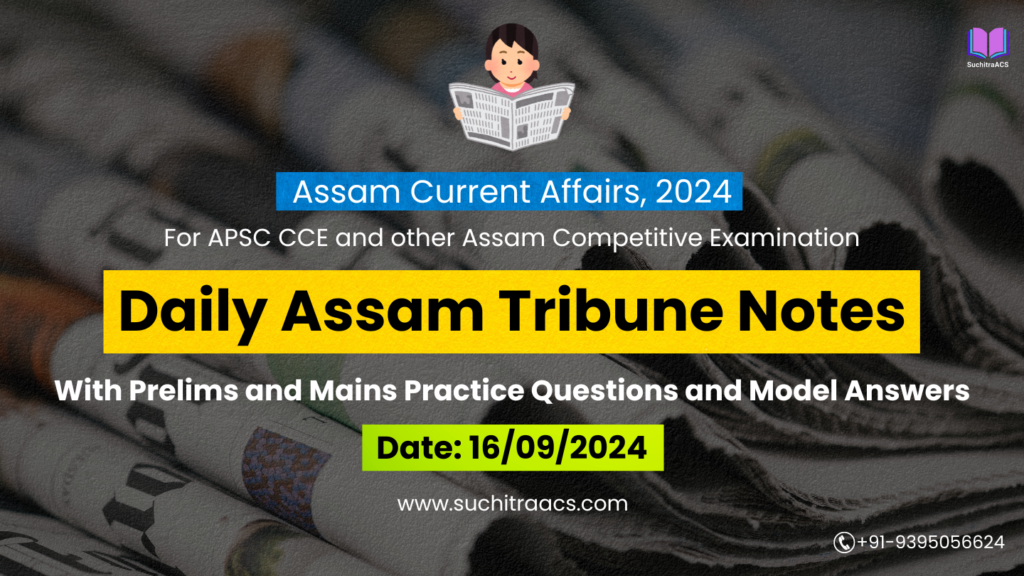APSC Current Affairs: Assam Tribune Notes with MCQs and Answer Writing (21/01/2025)
For APSC CCE and other Assam Competitive examinations aspirants, staying updated with current affairs is vital. This blog covers most important topics from the Assam Tribune today (21-01-2025). These issues are key for both APSC Prelims and Mains preparation, offering insights into the APSC CCE Syllabus.
1. Assam’s Solar Energy Push – A Step Towards Renewable Energy Transition
GS Paper 3: Environment, Energy Resources, and Infrastructure
Introduction
Assam is taking strides towards renewable energy with the commissioning of its largest solar power project in Dibrugarh. This initiative aims to reduce dependency on non-renewable energy sources, in line with India’s commitments under the Paris Agreement and its goal of achieving net-zero emissions by 2070.
Key Points
- Project Overview:
- Location: Dibrugarh district.
- Capacity: 120 MW, capable of powering approximately 1 lakh households.
- Developed through a public-private partnership model.
- Significance of the Project:
- Energy Transition: Reduces dependency on coal-based power plants.
- Economic Benefits: Creates jobs in construction, maintenance, and operation of solar plants.
- Environmental Impact: Mitigates carbon emissions by an estimated 1.2 million tons annually.
- Alignment with National Goals:
- Contributes to India’s target of achieving 500 GW of non-fossil fuel capacity by 2030.
- Part of Assam’s Renewable Energy Policy 2022, which focuses on promoting solar and wind energy.
Prelims Pointers
- Paris Agreement (2015): A global treaty to limit global warming to well below 2°C above pre-industrial levels.
- Assam Renewable Energy Policy 2022: Focuses on solar parks, rooftop solar installations, and waste-to-energy projects.
- Net-Zero Target (India): Achieve carbon neutrality by 2070.
Mains Pointers
Significance of Solar Energy for Assam:
- Energy Security:
- Reduces dependence on imported coal and fossil fuels.
- Diversifies the energy mix with a focus on indigenous resources.
- Economic Development:
- Encourages private sector participation in renewable energy.
- Boosts rural employment through the establishment of solar parks.
- Environmental Benefits:
- Reduces greenhouse gas emissions.
- Improves air quality and mitigates climate change impacts.
Challenges in Solar Energy Adoption:
- Land Acquisition Issues:
- Limited availability of non-agricultural land for large-scale solar installations.
- High Initial Costs:
- Capital-intensive projects require significant government subsidies or private investment.
- Grid Integration:
- Lack of adequate infrastructure for integrating renewable energy into the power grid.
Government Initiatives Supporting Renewable Energy:
- National Solar Mission (NSM): Promotes solar energy with a target of 280 GW by 2030.
- Production Linked Incentive (PLI) Scheme: Encourages domestic manufacturing of solar panels and equipment.
- KUSUM Scheme: Promotes solar energy adoption in the agricultural sector.
Way Ahead:
- Policy Strengthening:
- Streamline land acquisition processes and incentivize private investments.
- Technology Advancements:
- Promote research in efficient solar panel technology and energy storage systems.
- Capacity Building:
- Train local communities for jobs in renewable energy projects.
- Infrastructure Development:
- Strengthen grid systems to accommodate renewable energy.
Conclusion
Assam’s solar energy project in Dibrugarh signifies a critical step in its renewable energy transition. By addressing challenges and leveraging technological advancements, Assam can position itself as a leader in sustainable energy, contributing to India’s broader climate goals.
2. Reviving Assam’s Handloom Industry Through E-Commerce
GS Paper 1: Indian Culture | GS Paper 3: Economy and Employment
Introduction
Assam’s handloom industry, known for its intricate designs and cultural significance, is receiving a digital boost. The Assam government has partnered with e-commerce platforms to expand market access for handloom products, including Muga silk, Eri silk, and traditional Gamusa, promoting economic growth and preserving cultural heritage.
Key Points
- Significance of Assam’s Handloom Industry:
- Cultural Heritage: Features traditional designs reflecting the state’s rich history.
- Economic Contribution: Employs over 15 lakh weavers, predominantly women.
- Export Potential: Products like Muga silk hold GI tag status, enhancing global appeal.
- Challenges Faced by the Sector:
- Lack of organized marketing and branding strategies.
- Competition from machine-made and imported textiles.
- Limited access to raw materials due to fluctuating prices.
- Recent Initiatives:
- E-Commerce Partnerships: Tie-ups with platforms like Amazon and Flipkart to sell handloom products globally.
- Digital Campaigns: Leveraging social media to promote Assam’s weaves under initiatives like ‘Vocal for Local.’
- Skill Upgradation: Training programs for weavers to improve production quality.
Prelims Pointers
- Muga Silk: Known as the “Golden Silk of Assam,” it is exclusive to the state and has GI tag status.
- Gamusa: A traditional handwoven cloth, symbolic of Assamese culture and identity.
- Assam Handloom Policy: Focused on marketing, innovation, and enhancing weaver welfare.
Mains Pointers
Significance of Reviving the Handloom Sector:
- Economic Impact:
- Generates rural employment and boosts incomes for women artisans.
- Strengthens Assam’s position in India’s textile exports.
- Preservation of Cultural Identity:
- Protects traditional weaving techniques and designs.
- Promotes Assam’s heritage at national and international levels.
- Global Reach:
- Enhances Assam’s soft power by showcasing indigenous craftsmanship globally.
Challenges:
- Technological Deficiency:
- Limited adoption of modern tools and e-commerce by rural weavers.
- Raw Material Shortage:
- Rising costs of silk and cotton impact affordability.
- Inconsistent Quality Standards:
- Lack of standardized grading and certifications reduces export potential.
Government Initiatives:
- Assam Handloom Policy 2021: Promotes innovation, marketing, and financial support for weavers.
- Samarth Scheme: Provides training and capacity building for artisans.
- North East Region Textiles Promotion Scheme (NERTPS): Supports infrastructure development in handloom clusters.
Way Ahead:
- Strengthening Market Linkages:
- Expand partnerships with global e-commerce platforms and enhance branding.
- Adopting Technology:
- Train weavers in digital tools for design and sales management.
- Raw Material Support:
- Provide subsidies for silk and cotton procurement to stabilize costs.
- Policy Reforms:
- Introduce quality certification for exports to increase global competitiveness.
Conclusion
Reviving Assam’s handloom industry through e-commerce not only addresses economic challenges but also safeguards its rich cultural heritage. With the right combination of technology, policy support, and global outreach, the sector can thrive and make a lasting impact on both local livelihoods and the global textile market.
3. Illegal Coal Mining and its Impact on Dehing Patkai National Park
GS Paper 3: Environment
Introduction
Illegal coal mining activities in the Dehing Patkai National Park, Assam, have caused extensive environmental degradation, posing significant threats to the ecosystem and wildlife. Known as the “Amazon of the East,” Dehing Patkai is one of India’s biodiversity hotspots and a crucial ecological zone.
Key Points
- Biodiversity of Dehing Patkai:
- Home to numerous species of flora and fauna, including endangered ones like the clouded leopard and Asiatic elephant.
- Houses several endemic species, making it vital for India’s ecological balance.
- Environmental Impact of Illegal Mining:
- Destruction of forest cover leads to habitat fragmentation.
- Soil erosion and contamination of nearby water bodies from mining runoff.
- Increased air and noise pollution due to mining operations.
- Socio-Economic Concerns:
- Endangers local tribal communities reliant on the forest for livelihood.
- Raises health concerns due to pollution in surrounding areas.
- Regulatory and Governance Challenges:
- Lack of stringent enforcement of environmental laws.
- Inefficient monitoring of mining activities in protected zones.
Prelims Pointers
- Dehing Patkai National Park: Declared a national park in 2021; located in Assam.
- Clouded Leopard: Found in Dehing Patkai; categorized as vulnerable under the IUCN Red List.
- Environmental Protection Laws: Governed by the Forest Conservation Act and Wildlife Protection Act.
Mains Pointers
Significance of Dehing Patkai:
- Ecological Role:
- Provides carbon sequestration and regulates microclimate.
- Acts as a wildlife corridor, linking forest reserves.
- Economic Contributions:
- Promotes eco-tourism, generating revenue for the local economy.
- Supports traditional livelihoods of indigenous communities.
Challenges:
- Encroachment by mining companies despite legal protections.
- Weak institutional mechanisms to prevent illegal activities.
- Delayed implementation of eco-restoration measures.
Government Initiatives:
- Notification of Dehing Patkai as a national park for increased protection.
- Efforts to relocate illegal settlements and ensure compliance with mining regulations.
Way Ahead
- Policy Reforms:
- Strengthen penalties for violations of environmental laws.
- Conduct regular audits of mining activities.
- Community Participation:
- Empower local communities to act as guardians of the forest.
- Provide alternative livelihood options to reduce dependence on mining.
- Restoration Efforts:
- Implement afforestation drives in degraded areas.
- Rehabilitate affected ecosystems and wildlife habitats.
Conclusion
Dehing Patkai represents Assam’s rich natural heritage and requires urgent conservation efforts to preserve its biodiversity. Collaborative actions involving government, communities, and non-governmental organizations can ensure sustainable management of this critical ecosystem.
4. Assam’s Push for AI-Based Agriculture Development
GS Paper 3: Science and Technology, Agriculture
Introduction
The Assam government is leveraging artificial intelligence (AI) to enhance agricultural productivity and address challenges such as climate variability, pest infestations, and inefficient resource utilization. With partnerships involving private firms and research institutions, AI-based tools aim to modernize Assam’s traditional agricultural practices.
Key Points
- Scope of AI Applications in Agriculture:
- Precision Farming: AI-based systems analyze soil health, weather patterns, and irrigation needs to optimize crop yield.
- Early Pest Detection: AI tools use drones and sensors to identify pest infestations early, reducing crop losses.
- Crop Forecasting: Machine learning models predict harvest cycles and market demand, benefiting both farmers and policymakers.
- Ongoing Initiatives in Assam:
- Collaboration with agri-tech start-ups to implement AI-based soil mapping.
- Launch of mobile apps providing farmers with real-time advisory on weather, pest management, and best practices.
- Pilot programs integrating AI for efficient water management in tea plantations.
- Potential Benefits for Assam:
- Increased Productivity: Ensures optimal resource use and enhances yields.
- Cost Efficiency: Reduces input costs for fertilizers, pesticides, and water.
- Climate Resilience: Helps farmers adapt to unpredictable weather patterns.
Prelims Pointers
- Precision Farming: Farming approach using AI, IoT, and sensors to enhance productivity.
- Soil Mapping: AI-based analysis of soil characteristics to guide crop selection and fertilizer use.
- AI in Tea Plantations: Technology integration for pest detection and irrigation optimization in Assam’s tea sector.
Mains Pointers
Significance of AI in Assam’s Agriculture:
- Economic Growth:
- Improves income stability for farmers by reducing crop losses.
- Opens avenues for agri-tech investments and start-ups.
- Sustainability:
- Minimizes overuse of chemical inputs, reducing environmental degradation.
- Promotes water conservation through efficient irrigation systems.
- Empowering Farmers:
- Provides access to real-time data for informed decision-making.
- Encourages adoption of modern farming techniques among small and marginal farmers.
Challenges in Implementation:
- Technological Barriers:
- Limited digital literacy among farmers hinders adoption.
- Infrastructure Gaps:
- Inadequate internet connectivity in rural areas affects AI integration.
- Cost Constraints:
- High initial investment for AI tools and devices.
Government Initiatives Supporting Agri-Tech in Assam:
- Digital Agriculture Mission (2021-2025): Focus on digital tools for precision farming.
- Krishi Vigyan Kendras (KVKs): Promotes technology adoption in rural farming communities.
- PM Kisan Samruddhi Yojana: Provides financial assistance for agri-tech adoption.
Way Ahead:
- Capacity Building:
- Conduct digital literacy programs and workshops for farmers.
- Public-Private Partnerships:
- Encourage collaboration with tech firms and research institutes.
- Subsidies and Incentives:
- Provide financial support for AI tools and promote local manufacturing.
- Infrastructure Development:
- Strengthen rural internet connectivity to enable seamless AI integration.
Conclusion
AI has the potential to revolutionize Assam’s agricultural landscape by enhancing productivity, reducing costs, and fostering sustainability. By addressing infrastructural and literacy challenges, the state can become a pioneer in agri-tech innovations, empowering its farmers and boosting rural livelihoods.
APSC Prelims Practice Questions
1. Assam’s Solar Energy Push – A Step Towards Renewable Energy Transition
Question 1:
What is the capacity of Assam’s largest solar power project recently commissioned in Dibrugarh?
(a) 100 MW
(b) 120 MW
(c) 150 MW
(d) 200 MW
Answer: (b) 120 MW
Explanation: Assam’s largest solar power project, located in Dibrugarh, has a capacity of 120 MW and aims to power approximately 1 lakh households.
Question 2:
Which of the following is a primary target under India’s National Solar Mission?
(a) Achieve 280 GW solar capacity by 2030
(b) Reduce CO2 emissions by 40% by 2025
(c) Achieve net-zero emissions by 2050
(d) Electrify all villages by 2023
Answer: (a) Achieve 280 GW solar capacity by 2030
Explanation: The National Solar Mission aims to achieve 280 GW of solar energy capacity by 2030 as part of India’s renewable energy transition.
Question 3:
Which policy supports solar and wind energy initiatives in Assam?
(a) Assam Renewable Energy Policy 2022
(b) North-East Solar Development Policy 2021
(c) National Climate Resilience Framework 2020
(d) Assam Energy Conservation Act
Answer: (a) Assam Renewable Energy Policy 2022
Explanation: This policy focuses on developing solar parks, rooftop solar installations, and waste-to-energy projects in Assam.
2. Reviving Assam’s Handloom Industry Through E-Commerce
Question 4:
Which product from Assam holds a GI tag and is known as the “Golden Silk of Assam”?
- (a) Eri Silk
- (b) Tassar Silk
- (c) Muga Silk
- (d) Mulberry Silk
Answer: (c) Muga Silk
Explanation: Muga Silk, exclusive to Assam, is a GI-tagged product known for its durability and golden hue.
Question 5:
What is the significance of Gamusa in Assamese culture?
- (a) Used as traditional clothing for farmers
- (b) A symbolic handwoven cloth representing Assamese identity
- (c) A product exclusively used in tea gardens
- (d) A type of decorative wall hanging
Answer: (b) A symbolic handwoven cloth representing Assamese identity
Explanation: Gamusa is a cultural icon in Assam, representing respect and identity, often gifted during ceremonies and festivals.
Question 6:
Which scheme provides training and capacity building for handloom weavers in India?
- (a) Samarth Scheme
- (b) PM Rozgar Yojana
- (c) Digital Weaver Development Mission
- (d) Textile Export Promotion Scheme
Answer: (a) Samarth Scheme
Explanation: The Samarth Scheme focuses on upskilling weavers and artisans in traditional and modern techniques to enhance their employability.
3. Illegal Coal Mining and its Impact on Dehing Patkai National Park
Question 7:
Which national park in Assam is referred to as the “Amazon of the East”?
- (a) Kaziranga National Park
- (b) Manas National Park
- (c) Dehing Patkai National Park
- (d) Dibru-Saikhowa National Park
Answer: (c) Dehing Patkai National Park
Explanation: Known for its rich biodiversity and dense rainforest, Dehing Patkai is often called the “Amazon of the East.”
Question 8:
Which of the following animals is categorized as vulnerable under the IUCN Red List and found in Dehing Patkai?
- (a) Bengal Tiger
- (b) Clouded Leopard
- (c) Indian Pangolin
- (d) Red Panda
Answer: (b) Clouded Leopard
Explanation: The clouded leopard, found in Dehing Patkai, is a vulnerable species according to the IUCN Red List.
Question 9:
Which law governs forest conservation and prohibits mining in protected areas?
- (a) Wildlife Protection Act, 1972
- (b) Environment Protection Act, 1986
- (c) Forest Conservation Act, 1980
- (d) Biological Diversity Act, 2002
Answer: (c) Forest Conservation Act, 1980
Explanation: The Forest Conservation Act, 1980, regulates the diversion of forest land for non-forestry purposes, including mining.
4. Assam’s Push for AI-Based Agriculture Development
Question 10:
What does precision farming focus on?
- (a) Large-scale monoculture
- (b) Utilizing AI and IoT for optimized resource use
- (c) Organic farming using traditional techniques
- (d) Establishing large commercial farms
Answer: (b) Utilizing AI and IoT for optimized resource use
Explanation: Precision farming leverages AI and IoT to monitor and optimize resources such as water, fertilizers, and pesticides.
Question 11:
Which government initiative promotes digital tools in agriculture, including AI?
- (a) National Agriculture Innovation Scheme
- (b) Digital Agriculture Mission (2021-2025)
- (c) AI for Rural India Mission
- (d) Agri-Tech India Program
Answer: (b) Digital Agriculture Mission (2021-2025)
Explanation: This initiative focuses on integrating digital technologies like AI into farming practices.
Question 12:
What is the primary use of AI in Assam’s tea plantations?
- (a) Mechanized plucking of tea leaves
- (b) Early pest detection and irrigation optimization
- (c) Automating packaging processes
- (d) Marketing and distribution
Answer: (b) Early pest detection and irrigation optimization
Explanation: AI tools are being used in Assam’s tea plantations for pest detection and efficient water management.
APSC Mains Practice Question
Q. Discuss the significance of renewable energy and digital innovation in Assam’s development. Highlight the challenges in implementing solar energy projects and AI-based agricultural practices, and suggest measures to overcome them. (15 Marks, 250 Words)
Model Answer
Introduction
Assam, with its abundant natural resources and agricultural base, is leveraging renewable energy and AI-driven digital innovation to accelerate its development. The state’s largest solar project in Dibrugarh and AI-based precision farming initiatives exemplify this transformation, aiming to achieve sustainability and economic growth.
Body
Significance of Renewable Energy and Digital Innovation:
- Renewable Energy:
- Energy Security: Reduces dependence on coal and fossil fuels, diversifies the energy mix.
- Economic Growth: Creates jobs and boosts local manufacturing in solar equipment.
- Environmental Sustainability: Mitigates carbon emissions, supporting India’s net-zero target.
- AI in Agriculture:
- Enhances productivity through precision farming, reducing input costs and wastage.
- Empowers farmers with real-time data on crop health, pest management, and weather forecasts.
- Strengthens Assam’s tea and rice sectors with modern practices, ensuring climate resilience.
Challenges in Implementation:
- Solar Energy Projects:
- Land Acquisition Issues: Scarcity of non-agricultural land for large installations.
- High Costs: Initial investments in solar technology remain a hurdle.
- Grid Infrastructure: Inadequate systems to integrate renewable energy.
- AI-Based Agriculture:
- Technological Barriers: Limited digital literacy among farmers.
- Infrastructure Gaps: Poor rural internet connectivity.
- Cost Constraints: High costs of AI tools and sensors hinder widespread adoption.
Measures to Overcome Challenges:
- Policy Reforms:
- Streamline land acquisition processes and incentivize renewable energy projects.
- Promote public-private partnerships for funding and expertise.
- Capacity Building:
- Conduct farmer training programs to improve digital literacy.
- Establish vocational centers focused on AI applications in agriculture.
- Infrastructure Development:
- Expand rural internet connectivity to support AI integration.
- Strengthen grid systems to accommodate renewable energy efficiently.
- Technological Innovation:
- Invest in research to develop affordable solar and AI technologies tailored to local needs.
Conclusion
Renewable energy and digital innovations, such as AI, hold transformative potential for Assam’s economy and environment. By addressing implementation challenges through targeted reforms and capacity-building measures, the state can position itself as a leader in sustainable development, contributing to India’s broader goals of energy security and climate resilience.
✨ APSC Prelims Crash Course, 2025
at most affordable rate in Assam!

🔔 Join Our WhatsApp Study Group!
For exclusive access to premium quality content, including study materials, current affairs, MCQs, and model answers for APSC CCE and other Assam competitive exams.
Click here to join: SuchitraACS Study WhatsApp Group
📚 Want to know more about SuchitraACS’s most affordable courses?
Click here to know more: SuchitraACS Courses for APSC CCE and Assam Competitive Examinations




